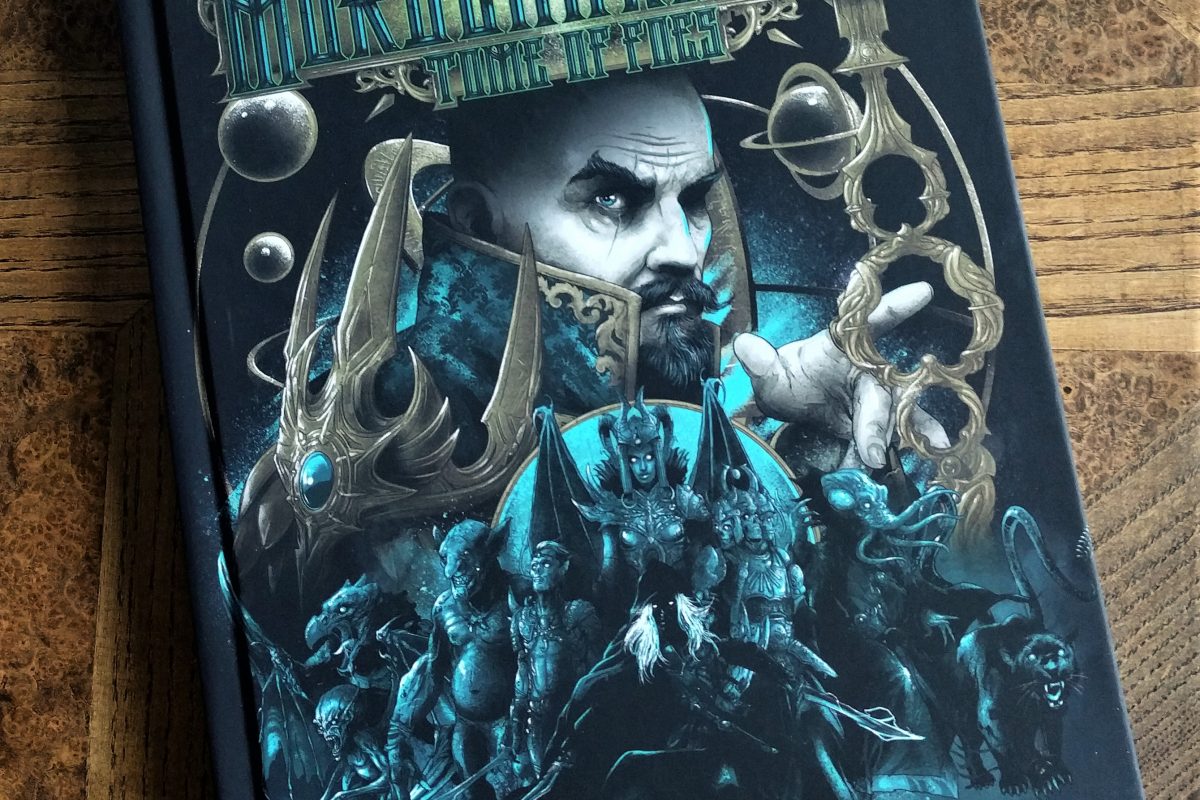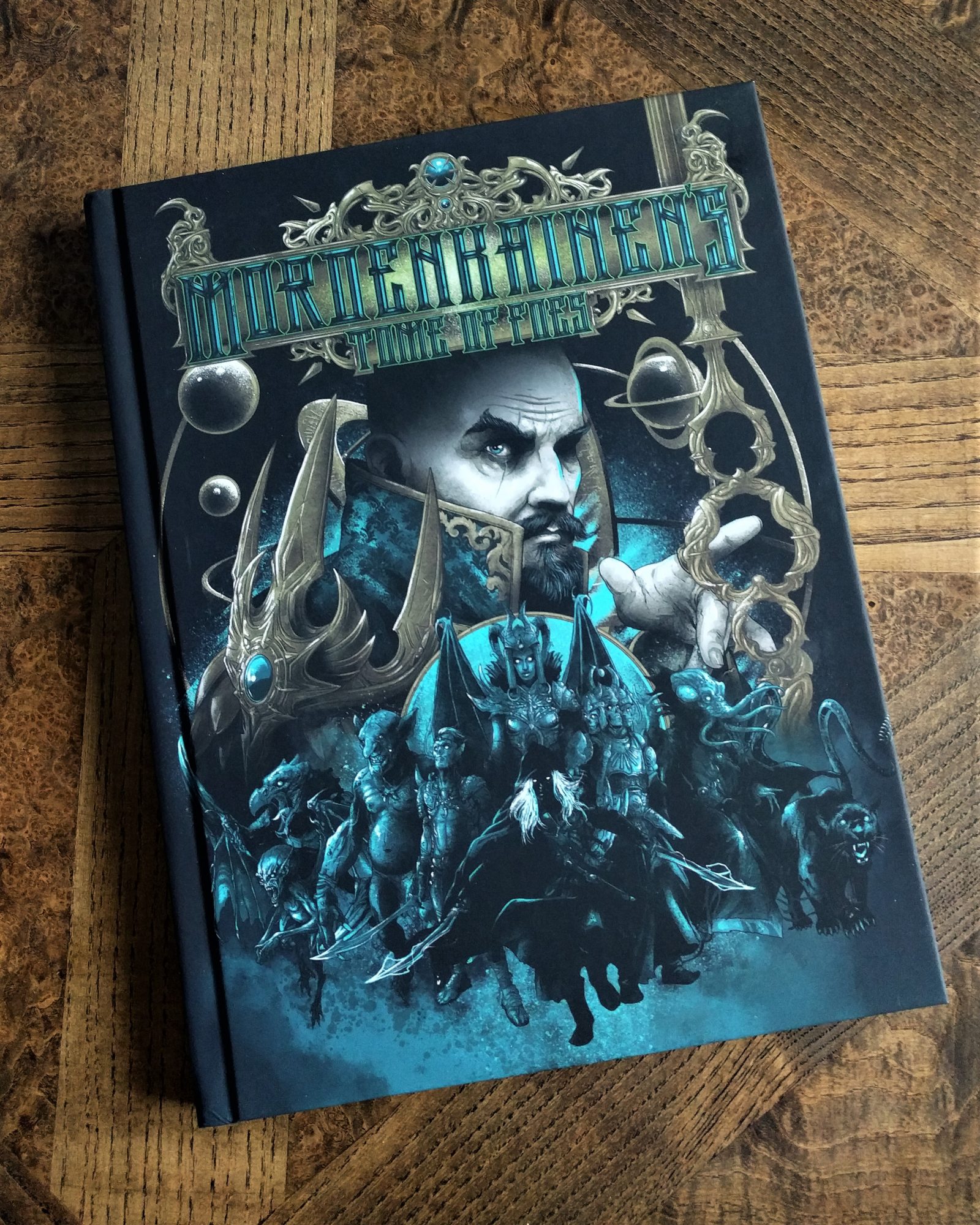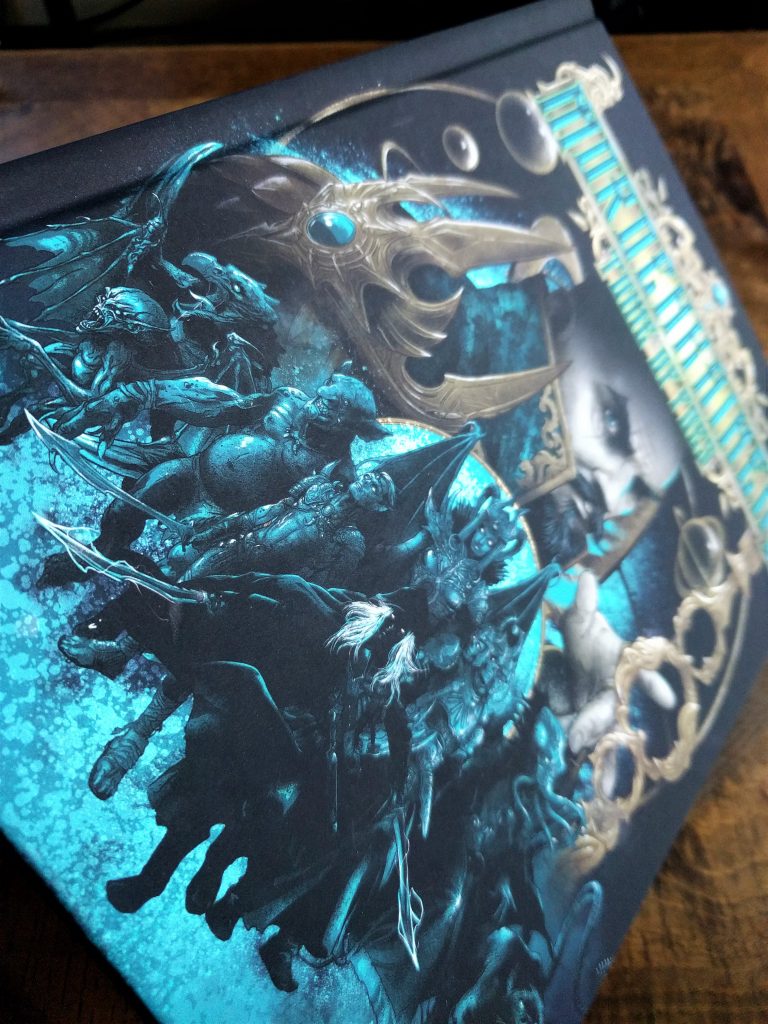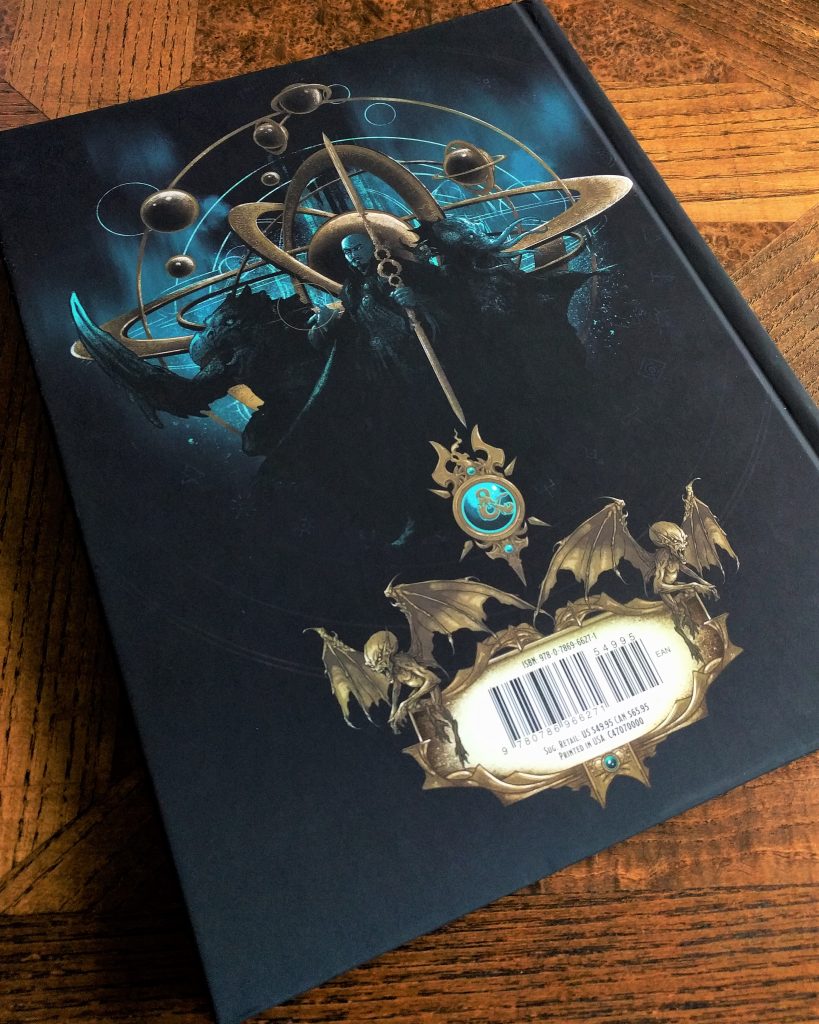In our second ever WotC official review we take a look at the brand new book Mordenkainen’s Tome of Foes. Most people know a few things about this book by now: “It’s got plane stuff in it” being chief among them. Who is this book for? What will you find useful between the covers? Well, let’s take a close look; after all, only you can decide if its worth your precious monies.
All Art from Wizards of the Coast LLC for review purposes.
Limited Edition Cover
The limited edition is supposed to retail for the same price as the non-special edition book ($50 USD). That’s not stopping some stores from selling them for $60-$100 however. Is the increased price worth it?
The book has a mostly-matte finish that I enjoy quite a lot. Like Volo’s Guide and Xanathar’s – I can also tell you that the book will begin to flake this matte coating off. It’s just the nature of books – they rub together and against the fabric inside your bag ceaselessly – so some wear is expected, no?
The real selling point is the art – and holy crap is is good. Dozens of creatures from within the book make an appearance as well as Murdy-Gurdy himself. He is far more put together these days than when I saw him in Curse of Strahd.
The foil-like metallic finish underneath the blue portions and gold portions of the book is also… entirely too pretty… but having seen that, as well, it will peel off, flake off, and rub off if the book is used too much.
In the end, if the art grabs you and you can manage, get it! If your store is trying to hit you with a $50 increase in price, go shop around. Other stores wont screw you like that (I hope). I’d not pay extra for this book knowing that it will see heavy use from me, though.
Preface and Introduction
I like that the preface is very direct as far as a summary of the contents within the book. There are little blurbs through the book from Bigby, Mordenkainen, and Shemeshka the Marauder as well as others. I’m not really sure these are for me. I recall the little notes from Xanathar also being kinda meh but I absolutely love Mordenkainen, so these go over a bit better for me.
Essentially, the book is split between chapter 1-5 and chapter 6. The first five are, arguably, useful to anyone that likes D&D (player or DM), and chapter 6 is almost exclusively for DMs – unless you’re one of those insufferable players that tries to study the various monster manuals and shout “MEDUSA! It’s a medusa. Medusa? Yeah, medusa. I’m betting it’s a medusa – we should stay far back so we don’t get turned to stone.”
[if you are that player, no one likes that – cut it out]
A brief excerpt from the text:
The first five chapters present material for a Dungeon
Master to add depth to a campaign that involves the ongoing
conflicts described there. Options for players are
provided as well, including new character races.
So if you’re a player who loves to have insider information before you cook up characters, reading through these chapters should be able to fuel your characters and give more reasoning behind these time-honored traditions within D&D.
The book beyond chapter 5 is entirely for monsters, encounter manipulation, and the like. 95% of players will get very-little-to-no use out of the last chapter, which is 142 pages. Is that a deal breaker for players? Let’s decide together.
Chapter 1: The Blood War
Demons and Devils clash eternally. If you ever want the who/what/when/where/why of the Blood War, this chapter has quite a bit of useful information in it.
The chapter goes into detail of how the battle mechanics actually work – what routes the sides take to strike at one another on their battlefields within the Abyss and the Nine Hells. It relays information on the roles Mortals play in their ceaseless war.
What I enjoy most about this chapter is that it gives DMs and Players alike a peek behind the curtain of the entire PLOT behind the war. Sometimes players can stagnate, not knowing what to do or who to kill in order to proceed, but with some of this information in mind, a player might be able to better guide the story.
Example:
The Ascendants, an adventuring party 8 members strong, have found themselves trying to find a way into the Abyss to rescue a comrade’s soul – dragged back to that plane by the demon lord Graz’zt.
DM: “So, how do you guys want to proceed? You need to find a way into the abyss, but how do you want to do it?”
Player 1: “I… guess we pay someone?”
Player 2: “I can cast Plane Shift, but… we don’t have a fork tuned to the abyss, do we?”
Player 3, thinking about Mordenkainen’s Tome of Foes: “Well… What if we talk to Granny Doris Rottenteeth – that hag might have worked for demons before… or maybe devils – we can barter with the Hag easier; they always need favors, right?”
DM, thinking: Sweet Jesus, that’s awesome “Yes. You know where she lairs, and hags of that age often don’t attack on sight, should you wish to try to speak to her.”
I have to tell you – many DMs shriek endlessly “CHARACTER KNOWLEDGE!!! METAGAMING!! HURRRRRDURRR!” but it’s supremely helpful for players to know how the game works and common knowledge about things like this – it drives the story, where a DM having to info dump the players and their characters every session ends up just feeling hallow and confusing.
Seeing the war from both sides of the fight makes this chapter supremely interesting to me. It not only lists off and describes the biggest movers and shakers of the Abyss and the Nine Hells, but it gives information about their cults, leaders, preferred spells (to flavor the Cultist stat block from the Monster Manual), and even has huge tables to customize devils and demons for your game.
“A pit fiend” is nowhere near as interesting as “Las’im the Vicious, a pit fiend hell bent on conquest through force. One who seeks not to corrupt the mortals, but to teach them enlightened self-interest.
Chapter 2: Elves
As someone who has spent the past 3 weeks listening to Drizzt novels, I really didn’t know all the information in this chapter… At all.
This chapter highlights the various subraces of Elves and why those subraces are so divided, including factual reasoning behind the split and wide variety of elves.
What I’ll get the most mileage out of will be the sections on Half-Elves and the elf life cycle! Ever think “man, they’re kids until they turn 100? What’s that like?” It’s written here, on these pages. From birth to aging and death. What this chapter strives to do is help you, mortal human reader, empathize with these near-perfect beings to better roleplay what life as an elf would be like. Did you know that many elves aren’t sticks-in-the-mud by choice, but because it’s ingrained in them? I owe a lot of apologies.
Likewise, you can read this chapter to get a better sense of how Elves react to existance different than humans: from crime to family, goals, sorrow, loss, anger, magic, adventure, religion. And it doesn’t do this with just one subrace of elves – but for each one! High elves, wood elves, Drow, Shadar-kai (including their relationship with the Raven Queen – a cult favorite!), Sea Elves, and Eladrin. Good lord at the elves. So many elves.
This chapter adds so much diversity and information about the Elf race that I am strongly considering running an entire game based around one player of each subrace of elves coming together – the scope of such a thing, after reading this, would be larger than anything I’ve ever attempted as a DM.
If you enjoy playing elves already this chapter is worth the cost of the book – everything else is bonus content for you.
Chapter 3: Dwarves and Duergar
I love the balance of Dwarves and Duergar – they’re so incredibly similar to the outside world, but could not be more different when looked upon through the lens of one another.
This chapter dives into the war between these two kindred peoples. Spoiler: Clan Duergar was a clan of dwarves in a bygone age… How heartbreaking does that feel? To know that bitter rivals who look upon one another as less-than were identical at one point. Ugh!
Just like with the elves, we get a clean, pure look at exactly what makes a Dwarf tick. The way they think, the way they consume themselves with work, how they feel about their clan and their shield-siblings. I cannot tell you how excited I am to use this information for my next Dwarf PC – exactly where they are from, what they did for their clan, why they are an adventurer, and what they hope to do can all be developed, honed, and polished with this one chapter.
Not playing in the Forgotten realms? Good news! Greyhawk and Dragonlance dwarves each get their own section within the chapter – explaining the subtle, yet important, differences for each.
What I like most is, by far, the strong ties this chapter makes between dwarves and their kin. The relationship between Duergar and Dwarves is cool and all, but really I’ve only seen Duergar one time in the history of me playing D&D – so how much use information about them will be might not be a great selling point. But if you’re looking to bolster your dwarven history, give your dwarf PC a much deeper and realistic feeling personality, please read this chapter. It’s very enlightening, and the art is phenomenal.
Chapter 4: Gith and Their Endless War
I’ve heard people scream about “spelljammer” almost every day for the better part of 2018 – I think this is why.
Where Dwarves and Elves have a lot of similarities to humans to draw upon, the Gith doooooon’t. They’re like a the Invaders from Invader Zim if they lived in Eternia along-side He-Man.
Gith are 500% not for me, but they’re still incredibly interesting to read about and keep far, far, FAR away from my games. Their astral vessels, city of death, dragon riding knights wielding silver swords of polished astral metals – a lot of it sounds really incredible for anyone who wants to venture into the skies for their campaigns!
Instead of getting a super close look from an RP standpoint, we get more of a useful overview of how Gith are split apart and how their societies work. Instead of imagining mountain-humans but _____, we have to imagine space pirate zealots with evil twins… it’s much more complex to learn, but this chapter does a good job!
Chapter 5: Halflings and Gnomes
In the most brutal and savage of all bloodbaths in the multiverse, there is no more of a vicious, organ crushing, bone-sucking desolation than that of Gnomes and Halflings!…. wait, no – nevermind. This chapter is just about them and how they’re super peaceful because no one notices them.
There is a big pitfall that comes with Gnomes and Halflings – people often play them like children or little people. But both Halflings and Gnomes have a very rich and diverse kind of culture to pull from – which I hate is lost a lot of the time.
Innocence and cheer are not all they have to offer, and this chapter goes into their superstitions, story telling, history (and how they tell it), deities, myths, and dynamics between people of their race. Halflings, for the most part, often work together to overcome bigger creatures and threats. Gnomes are more diverse in their sub-races than all the others, but still share a lot of common ground – leading me to think that all gnomes would come to the table with one another without much fuss.
There’s just SO MUCH here, particularly about gnomes, that there’s almost no way you could work it all into your game without spending dozens of sessions unveiling it all. And that’s what this book is for. It’s to set the framework for you to pull from to showcase a rich and deep culture under the surface of your PC – a nearly endless well to draw from.
Chapter 6: Bestiary
So… we get a boat load of monsters here. Many of them are from different planes of existence than what you’d find in the Monster Manual, but there are some re-prints here for people who wanted to pass up Out of the Abyss and the like.
To go into each one would be an act in futility – so i’ll summarize my gut reaction.
 There are a lot of higher level CR creatures here, which is very good. But a lot of them are little more than speed bumps to most parties. That’s the trouble with high level play – you have to grind and grind and grind and GRIND at your PCs for a long while before they’ve used even half of their resources. The good news is – if you need dozens of monsters to hurl at your players – between this and Volo’s Guide – you should have plenty!
There are a lot of higher level CR creatures here, which is very good. But a lot of them are little more than speed bumps to most parties. That’s the trouble with high level play – you have to grind and grind and grind and GRIND at your PCs for a long while before they’ve used even half of their resources. The good news is – if you need dozens of monsters to hurl at your players – between this and Volo’s Guide – you should have plenty!
Your best bet for this chapter, in my opinion, is to find a monster that interests you (I love the Orthon – basically Devil Bountyhunters) and create a campaign or campaign arch around that creature. There’s enough here to go on, for the most part.
My favorite parts of this chapter are the Campaign Ending level bad guys… The Demon Lords, the Archdevils, Drow Matron Mothers, and Elder Elementals.
The trick I’ve always suggested up till now was to re-skin creatures for your needs. And adding these dozens of additions to your toolbox will make nearly limitless creatures for you to use. Reading through the blurbs about these creatures can inspire literally dozens of campaigns.
Overall
I think this book is extremely well done and worth getting. The cover art and clean composition are great. It’s got tons of useful charts and information for players and DMs. DMs will get heavy use out of the 6th chapter, while players will generally only need the first 5 – but those five chapters are completely packed with useful and interesting information.
Not knowing what will come down the road makes this buy a little finicky. If the next book drags the characters through the planes of existence, this could be the best buy you’ve ever made.
If your characters tend to never hit level 10 because you cycle through games too fast for it, then all this additional information might be available to you online, if you dig deep enough.
Having it all in one place and translated to 5e is enough for me to buy the book two times over and I think that you’ll enjoy the hell out of it if D&D is even a passing fancy. I want to play an elf now, for the first time ever.
I don’t always advocate rolling, but when I do… be sure you have to Drop the Die.
Review by JB Little, Follow me on twitter for more “useful” information.











Grear review JB! I’m not even running a 5e game at the moment and your review made me consider picking this up. While it’s true that there’s tons of lore and stuff available regarding all the races as you mentioned, there’s also something just… nice about having a physical copy of this information. Additionally, given the impression you expressed here, it’s all the more worthwhile since the info was presented well.
Indeed! It was a surprise how inspiring the book really was.
Thanks for doing a review on this JB! I Love how you break it all down in an easy and enjoyable read. I’ll definitely want to pick up the special edition if I can find one (if only WoTC sold their books at FLGS’s in Mexico, doh!)
I had heard this was just a tome of monsters so wasn’t really interested since I have Volos, kobold’s Tome of Beasts (and soon Creature Codex), plus the monster manual. But what I’m craving is more lore to help my players and myself bring characters and the world to life, particularly in Greyhawk. The older Greyhawk stuff is a bit tough to read the way it was written but the 5e books seem to be less of a chore and more enjoyable to read.
Definitely going to get myself this book!
Very reassuring. I was starting to wonder if Murdy would be for me, and this seals the deal. Even if I don’t use it and it ends up being my players- I want then to have that background knowledge. I want that background knowledge. It took me a week of digging for the information I worked off of for my gnome’s backstory- having a resource book that has that information for many races and subraces? I’d almost pay the extra to have it immediately (except I really can’t afford that anyways).
Thanks so much for the review
You are MOST welcome!